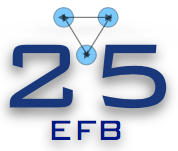Speaker
Description
Matter-wave interferometry with Bose-Einstein condensates (BECs) is a rapidly developing tool for precision measurements [1]. A crucial element of matter-wave interferometers is a beam-splitter that employs the interaction of atoms with laser beams and creates superposition of macroscopically occupied momentum states.
We consider the Bragg beam-splitting of an off-axis BEC with three-dimensional Gaussian laser beams [2]. The transverse position offset leads to the inseparability of the longitudinal and transverse motion during the pulse. Experimentally, this manifests as transverse momentum kicks. In order to describe both the Bragg oscillations between the momenta components and the motion of the BEC, we model the wavefunction of the condensate via a superposition of squeezed coherent states, initially separated by even multiples of laser photon momentum. We construct a Lagrangian field theory using the variational ansatz [3] that leads to a system of coupled Bragg-Schrödinger equations and Newtonian equations for the Bragg fragments. We compare our results with the (3+1)D numerical simulations, using realistic experimental parameters, and find a good agreement.
[1] D. Becker, et al., Nature 562, 391–395 (2018) \newline
[2] A. Neumann, et al., Phys. Rev. A 103, 043306 (2021) \newline
[3] R. Walser, et al. New J. Phys., 10(4), 045020 (2008)

